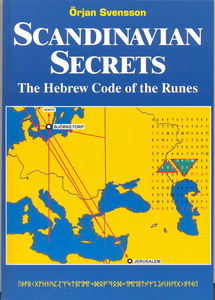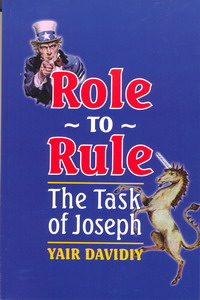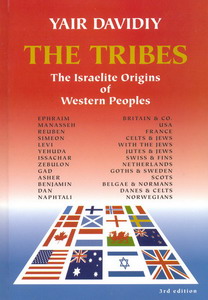Temporarily Inavailable

Brit-Am
Research
Revelation
Reconciliation
Facing A Revision of DNA Theory
|
|
Contents by Subject |
Home Research Revelation Reconciliation |
Publications |
Site Map Contents in Alphabetical Order |
This Site |
DNA Racial Classifications Refuted!
by Yair Davidiy on behalf of Brit-Am
Basic Argument of Article:
REP (Repeat Event Polymorphisms) -An Alternate Proposal
In the DNA literature one often comes across assumptions or facts that can only be explained by the presence of what we will call REP (Repeat Event Polymorphisms).
By REP we mean that instead of UEP (Unique Event Polymorphisms) being the rule they are the exception.
A DNA sequence reflects the state of a living organism. It has an inbuilt resilience allowing it to switch from one state to another under given circumstance.
The organism will react according to its inbuilt coding when encountering external stimuli.
Not only will one single organism react in the said way but large numbers when affected at the same time by the same circumstances.
According to this we would propose, for instance, that regardless of the haplogroups that originally reached a certain area external influences at certain stages cause them all to convert in a specific direction, e.g. J, G, and I (or some such) may anciently have come to the British Isles but in the course of time they all changed due to the environment or what not to R1b.
Sound fantastic?
It could be, yet archaeological DNA studies do indicate a much great diversity in the West than currently exists. Hg (Haplogroup) K for instance is an offshoot of the (F, G, H, I, J) group yet considered the forefather of
(K, L, M, P, N, O, Q, R). Hg K apart from Finland is rare now in Europe but in the ancient Basque area reached 16%. Similar phenomenon have been reported from much of Europe.
It may also be that changes do take place but only in certain directions and only under set conditions with a certain haplogroup being able to change only along limited parameters, etc.
This proposal appears to be within the boundaries of accepted scientific possibility and in accordance with known phenomenon.
As an example of this ability within DNA Coding to change in more than one location
(in REP, Repeat Event Polymorphisms) we have chosen to examine a case that has received much publicity and that is frequently held up as an example of the efficacy of DNA studies. Our example is an examination of the Cohen Modal Haplotype (CMH).
Article Being Updated and Revised.
Temporarily Inavailable
Very Important and Interesting Books - Read More -
and
Order Now!
http://britam.org/books.html
Click Here
>





http://www.britam.org/Role.html
For all Brit-Am Publications
Click Here

Basic Argument of Article:
REP (Repeat Event Polymorphisms) -An Alternate Proposal
In the DNA literature one often comes across assumptions or facts that can only be explained by the presence of what we will call REP (Repeat Event Polymorphisms).
By REP we mean that instead of UEP (Unique Event Polymorphisms) being the rule they are the exception.
A DNA sequence reflects the state of a living organism. It has an inbuilt resilience allowing it to switch from one state to another under given circumstance.
The organism will react according to its inbuilt coding when encountering external stimuli.
Not only will one single organism react in the said way but large numbers when affected at the same time by the same circumstances.
According to this we would propose, for instance, that regardless of the haplogroups that originally reached a certain area external influences at certain stages cause them all to convert in a specific direction, e.g. J, G, and I (or some such) may anciently have come to the British Isles but in the course of time they all changed due to the environment or what not to R1b.
Sound fantastic?
It could be, yet archaeological DNA studies do indicate a much great diversity in the West than currently exists. Hg (Haplogroup) K for instance is an offshoot of the (F, G, H, I, J) group yet considered the forefather of
(K, L, M, P, N, O, Q, R). Hg K apart from Finland is rare now in Europe but in the ancient Basque area reached 16%. Similar phenomenon have been reported from much of Europe.
It may also be that changes do take place but only in certain directions and only under set conditions with a certain haplogroup being able to change only along limited parameters, etc.
This proposal appears to be within the boundaries of accepted scientific possibility and in accordance with known phenomenon.
As an example of this ability within DNA Coding to change in more than one location
(in REP, Repeat Event Polymorphisms) we have chosen to examine a case that has received much publicity and that is frequently held up as an example of the efficacy of DNA studies. Our example is an examination of the Cohen Modal Haplotype (CMH).
Article Being Updated and Revised.
Temporarily Inavailable
See also:
Brit-Am
DNA Articles
Main Page
Offerings and Publications
Return to Question and Answer
Table of Contents
Temporarily Inavailable
Very Important and Interesting Books - Read More -
and
Order Now!
http://britam.org/books.html
Click Here

|

|

|

|
 http://www.britam.org/Role.html For all Brit-Am Publications Click Here |

|
Basic Argument of Article:
REP (Repeat Event Polymorphisms) -An Alternate Proposal
In the DNA literature one often comes across assumptions or facts that can only be explained by the presence of what we will call REP (Repeat Event Polymorphisms).By REP we mean that instead of UEP (Unique Event Polymorphisms) being the rule they are the exception.
A DNA sequence reflects the state of a living organism. It has an inbuilt resilience allowing it to switch from one state to another under given circumstance.
The organism will react according to its inbuilt coding when encountering external stimuli.
Not only will one single organism react in the said way but large numbers when affected at the same time by the same circumstances.
According to this we would propose, for instance, that regardless of the haplogroups that originally reached a certain area external influences at certain stages cause them all to convert in a specific direction, e.g. J, G, and I (or some such) may anciently have come to the British Isles but in the course of time they all changed due to the environment or what not to R1b.
Sound fantastic?
It could be, yet archaeological DNA studies do indicate a much great diversity in the West than currently exists. Hg (Haplogroup) K for instance is an offshoot of the (F, G, H, I, J) group yet considered the forefather of (K, L, M, P, N, O, Q, R). Hg K apart from Finland is rare now in Europe but in the ancient Basque area reached 16%. Similar phenomenon have been reported from much of Europe.
It may also be that changes do take place but only in certain directions and only under set conditions with a certain haplogroup being able to change only along limited parameters, etc.
This proposal appears to be within the boundaries of accepted scientific possibility and in accordance with known phenomenon.
As an example of this ability within DNA Coding to change in more than one location (in REP, Repeat Event Polymorphisms) we have chosen to examine a case that has received much publicity and that is frequently held up as an example of the efficacy of DNA studies. Our example is an examination of the Cohen Modal Haplotype (CMH).
Article Being Updated and Revised.
Temporarily Inavailable
See also:
Brit-Am
DNA Articles
Temporarily Inavailable
See also:
Brit-Am
DNA Articles
Main Page
Offerings and Publications
Return to Question and Answer
Table of Contents